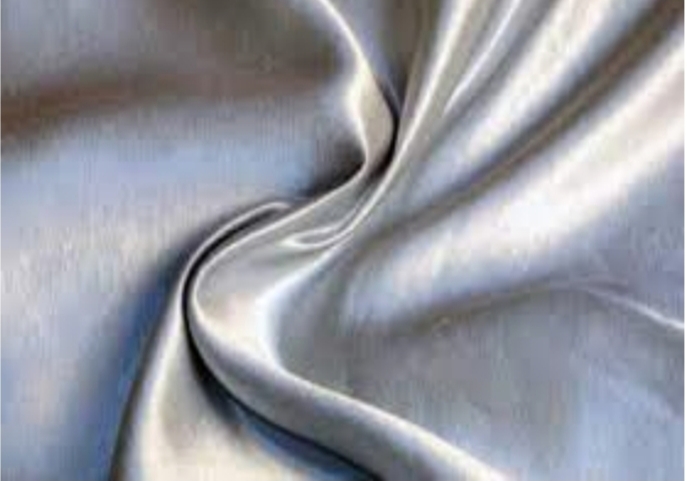Shape memory textile is an unique innovation of technical textile.It contains shape memory materials, shape memory polymers,shape memory alloys.
Materials with form memory have the ability to change their shape and cling to it, usually as a result
of heat. Shape memory materials, including metals, polymers, bi-material film laminates, and
encapsulated bigels, offer increased adaptability in the protection against temperature extremes
when incorporated into clothing. The air gap between adjacent layers of clothing widens when the
shape memory materials are activated in clothes, improving insulation. Shape memory alloys (SMA)
with differing qualities below and above the activation temperature, or the temperature at which
they are activated, include nickel-titanium and cuprous-zinc.
Shape-memory polymers (SMPs)
Shape memory polymers
consist of two polymer
components and ensuing two
phases, one with a higher
\smelting temperature than the
other . Due to its high molecular
weight, the first SMP
polynorborene is difficult to
tune; hence, styrene butadiene
SMPs were discovered, but their
manufacturing technique was
subpar. SMPs with styrene and
thermoplastic polyurethane bases have been
found. The structure, stimilus, and shape-
memory functions of SMPs are clearly depicted
in figure 2.
In addition to heat, SMPs can also be activated
by electric, optical, chemical, and magnetic
fields. They can be programmed in a variety of
ways, including with many steps. They are soft
and light enough to be used comfortably on
human flesh.
Shape-memory alloys (SMAs)
Metals with shape memory exhibit two distinct
qualities. The first is the shape memory effect,
which is determined by a material’s capacity.The material distorted or returned to its original shape as a result of the temperature change.
Superplasticity is the second factor. Material will show significant recoverable stresses in this state.
There are several different alloy species, however NiTi is currently the most popular alloy in the area.
It exhibits various behaviors depending on the activation temperature. The alloy can be easily
deformed below the activation temperature. The alloy exerts force to return to a previously accepted
shape and stiffens significantly at the
activation temperature.
Shape memory alloys contain two
phases known as austenite and
martensite.
Comparison between SMA& SMP
Shape memory metal alloys like nitinol were researched before shape memory polymers, however
the latter have a number of advantages.
They have a much greater capacity for growth than nitinol, for instance, they can double in size rather
than just grow by about 5%. This size increase allows for the creation of more intricate shapes for a range of applications.
The SMPs also feel softer and have a rubbery consistency, which may make them less likely to harm
surrounding tissue when used in biomedical equipment, however it is crucial that rigorous safety
assessments are conducted in such applications.
In comparison to form memory alloys, shape memory polymers are cheaper, denser, and easier to
produce. Additionally, they occasionally have better mechanical qualities than shape memory alloys.
Application Field
Primary uses for shape memory fabrics Shape memory textiles are used in a variety of contexts. They
can be utilized as actuators, which makes them very intriguing for soft robotics, where shape memory
materials powered by other stimuli can partially replace electric actuators. Similar to smart clothing,
applications in which it is possible to alter the dimensions or orientations of fabric components allow
for varying pressures to be applied to the human body, useful for everything from sports to the
treatment of wounds, opening or closing areas to alter air and water vapor permeability, or simply
producing clothing with high crinkle recovery.
The biological uses, on the other hand, should be mentioned. For instance, stents can profit from the
ability to be introduced into the body in a smaller shape and be stretched at the desired spot.
Finally, shape memory fabrics open up a wide range of new design opportunities for textiles and apparel.
Advantages
• High mechanical performances
• High power to weight ratio
• Large deformation
• Large actuation force
• High damping capacity
• High frequency response
• High wear resistance
• High corrosion & chemical resistance
• Low operation voltage
• High specific strength
• Compactness & lightness
Disadvantages
• Low energy efficiency
• Complex thermo-mechanical behaviour
• Expensive materials
• Temperature dependent effect
• Poor fatgue properties
• Low operational speed
Conclusion
Form memory Shape memory fibers can be used to create textiles by incorporating shape memory
wires, adding shape memory polymers via 3D printing, or coating. Despite the growing body of
research on 4D printing in general, there are still very few articles that discuss the potential for
adding a shape memory effect to textile textiles to make them smarter, more flexible, or just less
prone to wrinkles.
The majority of
shape memory materials used as fibers, integrated wires, or coatings recover due to thermal stimuli.
While providing a summary of the preparation and application options for shape memory textiles,
this paper also seeks to inspire more research in this incredibly intriguing area of study.
Writer’s Information:
Tasnim Tajmi Islam Arjita
Ahsanullah University of Science and Technology
Department of Textile Engineering
(Batch-40)


